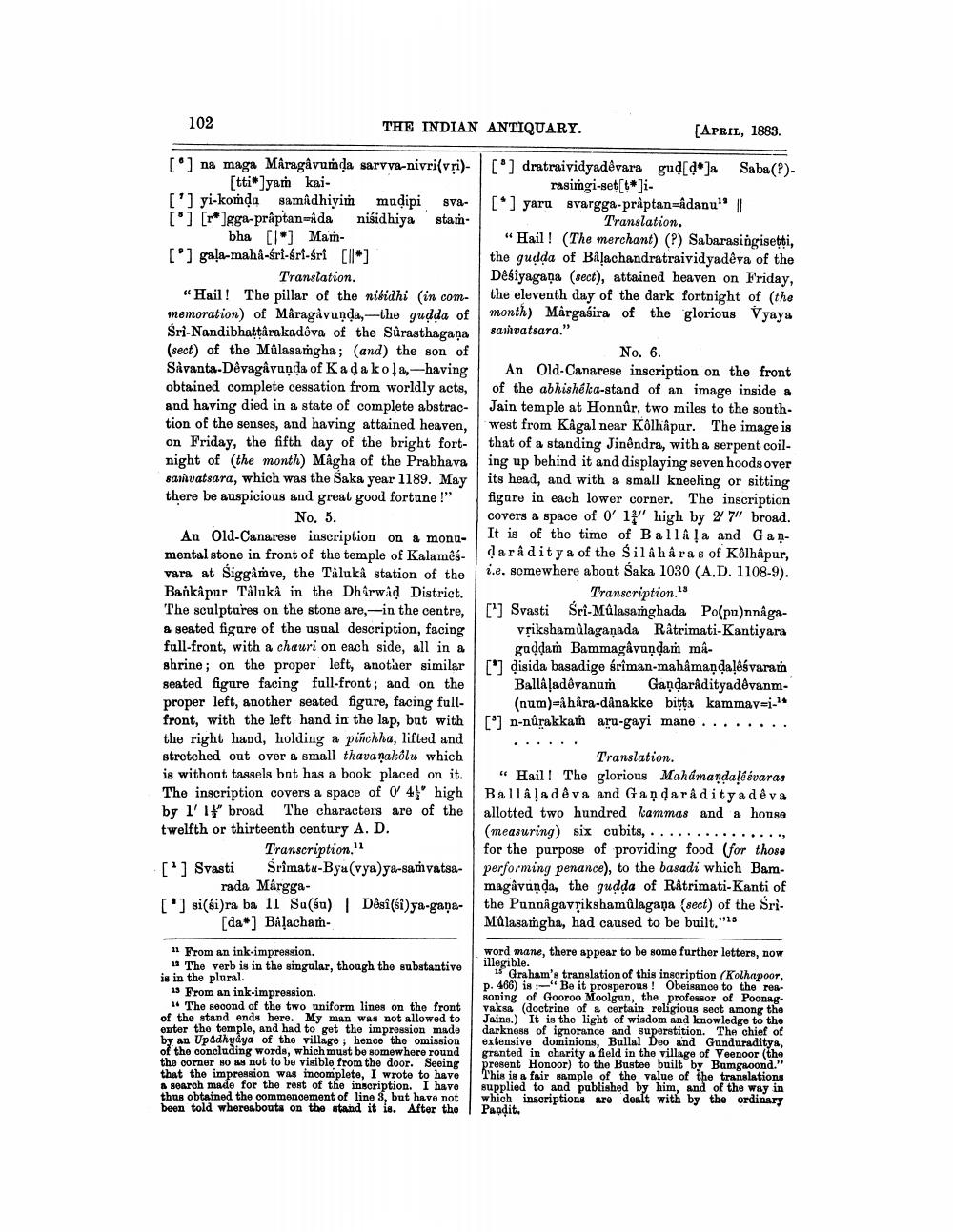________________
102
THE INDIAN ANTIQUARY.
[APRIL, 1883.
[] na maga Mâragâvunda sarvva-nivri(vri).
[tti*]yam kai'l yi-konda samadhiyim mudipisva- [°] [r*]gga-praptan-ada nisidhiya stam
bha [lo] Mam['] gala-maha-śri-sri-śrî [llo]
Translation “Hail! The pillar of the nibidhi (in commemoration) of Måragåvanda,--the gudda of Śri-Nandibhattarakadeva of the Surasthagana (sect) of the Malasamgha; (and) the son of Savanta.Devagåvanda of Kada kola, -having obtained complete cessation from worldly acts, and having died in a state of complete abstraction of the senses, and having attained heaven, on Friday, the fifth day of the bright fort- night of the month) Magha of the Prabhava saivatsara, which was the Saka year 1189. May there be auspicious and great good fortune!"
No. 5. An Old-Canarese inscription on a mongmental stone in front of the temple of Kalamesvara at Siggâmve, the Taluka station of the Bankapur Tåluka in the Dhirwad District. The sculptures on the stone are, --in the centre. & seated figure of the usual description, facing full-front, with a chauri on each side, all in a shrine; on the proper left, another similar seated figure facing full-front; and on the proper left, another seated figure, facing fullfront, with the left hand in the lap, but with the right hand, holding a piñchha, lifted and stretched out over a small thavaņakolu which is without tassels bat has a book placed on it. The inscription covers a space of 0 4) high by l' I broad The characters are of the twelfth or thirteenth century A. D.
Transcription." [?] Svasti Srimatu-Bya(vya)ya-samvatsa
rada Mârgga['] si(si)ra ba 11 Sa(sn) | Dési(sl)ya-gana
[da*] BAļacham
[°] dratraividyadêvara gud[qs]a Saba(?).
rasimgi-set[*]i. [°] yaru svargga-pråptan=adanu" |
Translation. "Hail! (The merchant) () Sabarasingisetti, the gudda of Balachandratraividyadêva of the Désiyagana (sect), attained heaven on Friday, the eleventh day of the dark fortnight of the month) Margasira of the glorious Vyaya sarivatsara."
No. 6. An Old-Canarese inscription on the front of the abhisheka-stand of an image inside a Jain temple at Honnûr, two miles to the southwest from Kågal near Kolhapur. The image is that of a standing Jinêndra, with a serpent coiling up behind it and displaying seven hoods over its head, and with a small kneeling or sitting figaru in each lower corner. The inscription covers a space of O' 1 high by 27" broad. It is of the time of Balla!a and Gandaråditya of the Silâhâ ras of Kolhapur, i.e. somewhere about Saka 1030 (A.D. 1108-9).
Transcription.18 [^] Svasti Sri-Múlasamghada Pospu)nnåga
vrikshamůlagañada Ratrimati-Kantiyara
gaddam Bammagåvandam ma['7 disida basadige sriman-mahamandalesvaram
Ballkladovanum Gandaradityaddvanm
(num)-ahára-dánakke bitta kammav=j[] n-nurakkam aru-gayi mane ........
Translation. " Hail! The glorious Mahamandalesvaras Balla!a dê va and Gandarâditya deva allotted two hundred kammas and a house (measuring) six cubits, ..............., for the purpose of providing food for those performing penance), to the basadi which Bammagavanda, the gudda of RAtrimati-Kanti of the Punnagavrikshamûlagana (sect) of the SriMalasamgha, had caused to be built."'18
11 From an ink-impression.
1 The verb is in the singular, though the substantivo is in the plural
13 From an ink-impression.
# The second of the two uniform lines on the front of the stand ends here. My man was not allowed to enter the temple, and had to get the impression made by an Upadhyaya of the village ; hence the omission of the concluding words, which must be somewhere round the corner so as not to be visible from the door. Seeing that the impression was moomplete, I wrote to have & search made for the rest of the inscription. I have thus obtained the commencement of line 3, but have not been told whereabouts on the stand it is. After the
word mane, there appear to be some further letters, now illegible.
15 Graham's translation of this inscription (Kolhapoor, p. 466) is :-"Be it prosperous ! Obeisance to the reasoning of Gooroo Moolgun, the professor of Poonagvaksa (doctrine of a certain religious sect among the Jains.) It is the light of wisdom and knowledge to the darkness of ignorance and superstition. The chief of extensivo dominions, Bullal Deo and Gunduraditya, granted in charity a field in the village of Veenoor (the present Honoor) to the Bustee built by Bumgaoond." This is a fair sample of the value of the translations supplied to and published by him, and of the way in which inscriptions are dealt with by the ordinary Paodit.




